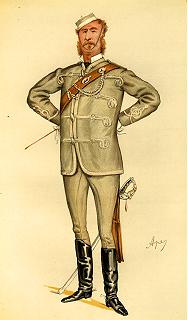Robert William Edis


Colonel Sir Robert William Edis KBE CB DL (13 June 1839 – 23 June 1927) was a British architect.[1][2]
Biography[]
Edis was born in Huntingdon to Emma and Robert Edis. His sister was the preacher Isabella Reaney,[3] his brother was Arthur Wellesley Edis, a gynaecologist,[4] and his niece through Arthur was the photographer Olive Edis.[5]
Edis was educated at Huntingdon Grammar School and Aldenham School before being articled to William Gilbee Habershon and Edward Habershon, architects, in London.[1][2] He became chief assistant to Anthony Salvin, and joined the Architectural Association in 1859.[1] He was admitted an Associate of the Royal Institute of British Architects in 1862 and a fellow of the association in 1867.[1]
Although his early work was Gothic, Edis later became a proponent of the Queen Anne style of baroque revival architecture. He worked mostly on private houses and public buildings, although he did design a few churches.[6]
He later became involved in the Aesthetic Movement of decorative arts and in furniture design, and delivered a series of Cantor lectures on the subject at the Royal Society of Arts. These formed the basis of two books: Decoration and Furniture of Town Houses (1881) and Healthy Furniture and Decoration (1884).[1][7]

From 1883, Edis extended and rebuilt Sandringham House in Norfolk for the Prince of Wales.[8][9] He was the designer of the British pavilion at the World's Columbian Exposition in Chicago in 1893.
He built a studio on Church Street, Sheringham, for his nieces the photographers Katherine and Olive Edis. It was their first studio and had a glass roof to allow in natural daylight which became an important aspect of their trademark style.[5]
Edis had a long association with the Volunteer Force and its successor the Territorial Force. In 1868 he received a commission in the Artists' Rifles.[10] He went on to be the regiment's commanding officer in 1883, and held the office of honorary colonel from 1909 until his death.[2][11][12] He designed the unit's drill hall at Duke's Road, off Euston Road, Camden (now The Place, home of the Contemporary Dance Trust).[13]
In January 1889 he was elected a member of the first London County Council, representing St Pancras South for three years as a member of the Conservative-backed Moderate Party.[14]
Edis had homes at Ormesby Old Hall, Great Ormesby, Norfolk, as well as Fitzroy Square[15] and Regent's Park, London.[16] He was a justice of the peace and a Deputy Lieutenant for Norfolk from 1901.[2][17] He was created a Knight Commander of the Order of the British Empire in 1919 for his military services.[18]
Edis died suddenly at his Norfolk home in 1927, aged 88.[2]
References[]
- ^ Jump up to: a b c d e Clerkin, Paul. "Edis, Sir Robert William (1839–1927)". Archiseek. Retrieved 25 March 2012.
- ^ Jump up to: a b c d e "Obituary: Sir R. W. Edis". The Times. 25 June 1927. p. 14.
- ^ "Reaney [née Edis], Isabella Emily Thomasa [Isabel] (1847–1929), preacher and social activist". Oxford Dictionary of National Biography (online ed.). Oxford University Press. 2004. doi:10.1093/ref:odnb/56693. Retrieved 29 June 2020. (Subscription or UK public library membership required.)
- ^ Neale, Shirley (1 November 1996). "Arthur Wellesley Edis (1840–1893): Obstetrician and Gynaecologist". Journal of Medical Biography. 4 (4): 200–207. doi:10.1177/096777209600400403. ISSN 0967-7720. PMID 11618388. S2CID 26815834.
- ^ Jump up to: a b Olive Edis; Alistair Murphy; Elizabeth Elmore (2017). Fishermen & kings: the photography of Olive Edis (Second ed.). Norwich. ISBN 978-0-903101-88-2. OCLC 1137104261.
- ^ "Architects and Artists D-E". Sussex Parish Churches. A primary source of information on churches in East and West Sussex. Archived from the original on 8 November 2011.
- ^ "Robert William Edis". Designer Biographies. Haslam and Whiteway. Retrieved 25 March 2012.
- ^ Jenkins 2003, p. 530.
- ^ Pevsner & Wilson 2002, p. 627.
- ^ "No. 23346". The London Gazette. 24 January 1868. p. 340.
- ^ "No. 25251". The London Gazette. 17 July 1883. p. 3588.
- ^ "No. 28287". The London Gazette. 10 September 1909. p. 6815.
- ^ Historic England. "The Place and attached railings, Camden (1342089)". National Heritage List for England.
- ^ "The County Councils – London Polls". The Times. 18 January 1889. p. 9.
- ^ "Fitzroy Square Pages 52-63 Survey of London: Volume 21, the Parish of St Pancras Part 3: Tottenham Court Road and Neighbourhood. Originally published by London County Council, London, 1949". British History Online. Retrieved 4 August 2020.
- ^ Brodie, Antonia (2001). Directory of British Architects 1834–1914: A-K. p. 588. ISBN 9780826455130.
- ^ "No. 27323". The London Gazette. 14 June 1901. p. 4005.
- ^ "No. 31395". The London Gazette. 16 June 1919. p. 7426.
| Wikimedia Commons has media related to Robert William Edis. |
| Wikisource has original works written by or about: Robert William Edis |
- 1839 births
- 1927 deaths
- People from Huntingdon
- Members of London County Council
- Knights Commander of the Order of the British Empire
- People educated at Aldenham School
- Architects from Cambridgeshire
- Deputy Lieutenants of Norfolk
- Companions of the Order of the Bath
- Artists' Rifles officers
- People from the Borough of Great Yarmouth